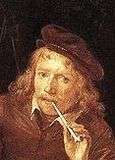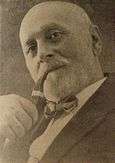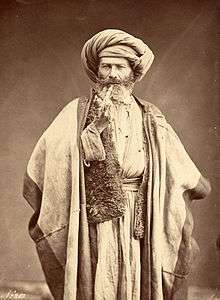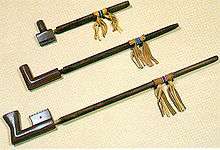Pipe smoking

Pipe smoking is the practice of tasting (or, more uncommonly, inhaling) the smoke produced by burning a substance, most commonly tobacco, in a pipe. It is the oldest traditional form of smoking.
History
A number of Native American cultures have pipe-smoking traditions, which have been part of their cultures since long before the arrival of Europeans. Tobacco is often smoked, generally for ceremonial purposes, though other mixtures of sacred herbs are also common. Various types of ceremonial pipes have been smoked in ceremony to seal covenants and treaties, most notably treaties of peace (hence the misnomer, "peace pipe"). Tobacco was introduced to Europe from the Americas in the 16th century and spread around the world rapidly.[1] In Asia during the 19th century, opium (which previously had only been eaten) was added to tobacco and smoked in pipes. Madak (the mixture of opium and tobacco) turned out to be far more addictive than orally-ingested opium, leading to social problems in China which culminated in the First (1839–1842) and Second Opium War (1856–1860).[1]
According to Alfred Dunhill, Africans have had a long tradition of smoking hemp in gourd pipes, asserting that by 1884 the King of the Baluka tribe of the Congo had established a "riamba" or hemp-smoking cult in place of fetish-worship. Enormous gourd pipes were used.[2]
In the 20th century, pipe smoking has been adopted as a preferred method of inhaling a variety of psychoactive drugs, and some claim it is a more intense method of ingestion. Smokeable crack cocaine has a reputation for being more addictive than cocaine's insufflated form. Similarly, methamphetamine has gained popularity in a crystalline form which when smoked in a pipe lets the user avoid the painful nasal irritation of snorting. When not applied to a cigarette or joint, the liquid form of PCP is typically smoked in a pipe with tobacco or cannabis.[3]
Pipes

Pipes have been fashioned from an assortment of materials including briar, clay, ceramic, corncob, glass, meerschaum, metal, gourd, stone, wood and various combinations thereof, most notably, the classic English calabash pipe.
The size of a pipe, particularly the bowl, depends largely on what is intended to be smoked in it. Large western-style tobacco pipes are used for strong-tasting, harsh tobaccos, the smoke from which is usually not inhaled. Smaller pipes such as the midwakh or kiseru are used to inhale milder tobaccos such as dokha and kizami or other substances such as cannabis and opium.
Water pipes
Water pipes bubble smoke through water to cool and wash the smoke. The two basic types are stationary hookahs, with one or more long flexible drawtubes, and portable bongs.
Culture
The customs, vocabulary and etiquette that surround pipe smoking culture vary across the world and depend both on the people who are smoking and the substance being smoked.
For example, in many places in Europe and North America, tobacco pipe smoking has sometimes been seen as genteel or dignified and has given rise to a variety of customized accessories and even apparel such as the smoking jacket, and the Pipe Smoker of the Year award in the UK, as well as the term kapnismology ("the study of smoke").[4]
The ceremonial smoking of tobacco or other herbs, as a form of prayer, is still practiced in a number of Native American religious traditions.
Cannabis culture has its own pipe smoking traditions which differ from tobacco pipe smoking. For example, unlike tobacco smokers, cannabis users frequently pass a single pipe among two or more partners.
In recent years, "hookah bars" have appeared in college towns and urban areas in America[5] and Europe.
Notable pipe smokers
A number of real and fictional persons are strongly associated with the hobby of pipe smoking.
Men
- Sparky Anderson, American baseball manager.[6]
- Clement Attlee, British prime minister .
- Johann Sebastian Bach, German composer. He wrote an aria about his fondness for pipe smoking: So oft ich meine Tobackspfeife BWV 515a
- Douglas Bader, British military pilot.
- Ludwig van Beethoven, German composer.
- Tony Benn, British politician.
- Edgar Benson, Canadian Minister of Finance.
- Georges Brassens, French singer and guitarist.
- Clarence "Gatemouth" Brown, American blues musician. An avid pipe smoker, the Texas-blues guitarist often sold his own proprietary blend of pipe tobacco as well as autographed pipes at his concerts and shows.[7]
- Graham Chapman, British actor and comedian (Monty Python).
- Jacques Cousteau, French documentary maker and oceanographer.
- Bing Crosby, American singer and actor.
- Edward VIII (Duke of Windsor),[8] British king.
- Albert Einstein, German scientist. He was known for smoking a pipe and once said, "I believe that pipe smoking contributes to a somewhat calm and objective judgment in all human affairs."
- Mircea Eliade, Romanian author and historian.
- William Faulkner, American author. Faulkner was known to be an enthusiastic proponent of pipe smoking.[9]
- Gerald R. Ford, 38th President of the United States[10]
- Stephen Fry, English author, actor and comedian.
- Clark Gable, American actor.
- George Gissing, English author.
- Cary Grant, British-American actor.
- Günter Grass, German novelist.
- Che Guevara, Argentine revolutionary, who was known to enjoy a pipe from time to time, in addition to his usual cigar.
- Dag Hammarskjöld Swedish diplomat, spiritual diarist and second Secretary General of the United Nations Organisation.
- Hugh Hefner, American publisher.
- Ernest Hemingway, American novelist.
- Earl Hines, American jazz musician.
- Herbert Hoover, 31st President of the United States[11]
- Edwin Hubble, American astronomer.
- Albert King, American blues singer and guitarist.
- C.S. Lewis, British author, theologian, professor.
- Subcomandante Marcos, Mexican revolutionary.
- General Douglas MacArthur, American general. He was often photographed with his signature corncob pipe.
- Thabo Mbeki, South African President.
- Eric Morecambe, British comedian.
- Harry Mulisch, Dutch novelist.
- Sandro Pertini, Italian president.
- Sheikh Mujibur Rahman, Bangladeshi politician.
- Franklin Delano Roosevelt, American president.
- Bertrand Russell, British philosopher.
- Jean-Paul Sartre, French philosopher.
- Helmut Schmidt, West-German Chancellor.[12]
- Samuel J. Seymour, the last surviving person who had been present in Ford's Theater the night of the assassination of U.S. President Abraham Lincoln on April 14, 1865
- Will Self, British author.
- Georges Simenon, Belgian novelist. His most famous character, Jules Maigret, is also a pipe smoker.
- Joseph Stalin, Russian head of state. He was frequently shown with a pipe: "Photos of him appeared daily in the Soviet press, now in genial pipe-smoking profile, now walking with his comrades..."[13]
- Jacques Tati, French actor, comedian and film director.
- J.R.R. Tolkien, British novelist.The Hobbit and The Lord Of The Rings have several detailed scenes of characters engaging in it. He himself was an avid pipe smoker.
- Mark Twain, American author, a.k.a. Samuel Clemens, writer of Huckleberry Finn favored Missouri Meershaum corncob pipes. He was notoriously partial to a special blend of "Cuban leaf" pipe tobacco, remarking once that "If I cannot smoke in heaven, then I shall not go."[14]
- Martin Van Buren, US President.
- Paul Vanden Boeynants, Belgian Prime Minister.
- Lee Van Cleef, American actor (as the Bad in The Good, The Bad & The Ugly.
- Vincent van Gogh, Dutch painter
- Harold Wilson, British Prime Minister.[12]
Women
- Millicent Fenwick, American politician
- George Sand, French writer
- Virginia Woolf, English writer
Fictional characters
- Olivier B. Bommel, Dutch comics character from Tom Poes.
- César, Belgian comics character from Urbanus.
- Cowboy Henk, Belgian comics character.
- Frosty the Snowman, A fictional Christmas character, featured in both songs and cartoon films of the same name, that is always depicted and described as "With a corncob pipe and a button nose, and two eyes made out of coal". Such depictions likely suggests that Frosty was a pipe smoker, or at least an aesthetic pipe proprietor.
- Captain Haddock, Belgian comics character from The Adventures of Tintin.
- Sherlock Holmes, British literary character. He is explicitly described as a pipe smoker.[15]
- Monsieur Hulot, French film character.
- Kapitein Rob, Dutch comics character. [16]
- M, British literary and film character (James Bond)
- Jules Maigret, Belgian literary character, created by Georges Simenon, who was also a pipe smoker.
- Mammy Hokum, American comics character from Li'l Abner.
- Philip Mortimer, Belgian comics character from Blake and Mortimer.
- L'Oncle Paul, Belgian comics character.
- Paulus the woodgnome, Dutch comics character.
- Madam Pheip, Belgian comics character from The Adventures of Nero. She is a bossy woman who always smokes pipe.
- Piet Pienter, Belgian comics character from Piet Pienter en Bert Bibber.
- Popeye, American comics and cartoon character, known for his corn pipe.
- Santa Claus, folklore character. Is described thus (1839): "The stub of a pipe he held clenched in his teeth."
More examples can be found in the Pipe Smoker of the Year list.
Health effects
The overall health risks are 10% higher in pipe smokers than in nonsmokers.[17] However, pipe or cigar smokers who are former-cigarette smokers might retain a habit of smoke inhalation.[17] In such cases, there is a 30% increase in the risk of heart disease and a nearly three times greater risk of developing COPD.[17] In addition, there is a causal relationship between pipe smoking and mortality due to lung and other cancers, as well as periodontal problems, such as tooth and bone loss.[17]
However, all tobacco products deliver nicotine to the central nervous system, and there is a confirmed risk of dependence. Many forms of tobacco use are associated with a significantly increased risk of morbidity and premature mortality due to tobacco-related diseases[17] but a WHO committee on tobacco has also acknowledged the evidence is inconclusive regarding health consequences for snuff consumers.[18]
Gallery
- Click on image for larger view
 Gerrit Dou: self-portrait with long-stemmed clay pipe (1645).
Gerrit Dou: self-portrait with long-stemmed clay pipe (1645). Man smoking kiseru. Cover illustration of the novel Komon gawa ("Elegant chats on fabric design") by Santō Kyōden, 1790.
Man smoking kiseru. Cover illustration of the novel Komon gawa ("Elegant chats on fabric design") by Santō Kyōden, 1790. Georgian composer, Meliton Balanchivadze smoking pipe.
Georgian composer, Meliton Balanchivadze smoking pipe. Extended mouthpiece for pipe smoking woman, who is performing in a circus. New York, 1930.
Extended mouthpiece for pipe smoking woman, who is performing in a circus. New York, 1930. Arab man smoking pipe, late 1800s.
Arab man smoking pipe, late 1800s.
 Various styles of Native American ceremonial pipes.
Various styles of Native American ceremonial pipes. Lord Wilson.
Lord Wilson.- Model, 1894, by F. Galofré.
- Portrait of a fisherman, 1890 by Dionís Baixeras
 Portrait of a muslim, 1880 by Simó Gómez
Portrait of a muslim, 1880 by Simó Gómez
See also
Substance-specific pipes
References
- 1 2 The Columbia Encyclopedia, Sixth Edition. 2001-05.
- ↑ [Dunhill, Alfred | "The Pipe Book" | London | A & C Black, 1924]
- ↑ National Trends in Drug Abuse
- ↑ Origin of kapnismology
- ↑ Hookah's New Haven
- ↑ Madden, Bill. "Sparky Anderson, a great manager with great stories, saw welcome wear thin with Reds and Tigers," Daily News (New York City), Friday, November 5, 2010.
- ↑ [Edwards, Martin, It All Comes Back, Pipes & Tobacco magazine, Spring 2002, pp. 14-17]
- ↑ Tobacco Pipe Prince Shape – TobaccoPipes.com.
- ↑ [Graves, K. Maxwell Jr., Pipe Smoking Friends--Famous and Infamous, Pipes & Tobacco magazine, Summer 2002, pp. 28-30]
- ↑ "The Briar Files: A blog about pipes and pipe smoking.". 14 November 2009. Retrieved 15 November 2013.
- ↑ "Pipes, People and Dealing with Stress". PipesMagazine.com. 1 July 2009. Retrieved 16 November 2013.
- 1 2 "Famous Pipe Smokers". Alt Smokers Pipe. Retrieved 16 November 2013.
- ↑
- ↑
- ↑ A Sherlock Holmes related bibliography, includes quite a few articles devoted to smoking habits of Mr. Holmes
- ↑ https://www.lambiek.net/artists/k/kuhn.htm
- 1 2 3 4 5 Viegas CA. Noncigarette forms of tobacco use. J Bras Pneumol. 2008;34(12):1069–73. doi:10.1590/S1806-37132008001200013. PMID 19180343.
- ↑ http://www.irishtimes.com/newspaper/health/2009/0421/1224245059341.html[]
External links
- Smoking Pipes, Estate Pipes, Pipe Tobacco: Smoking Pipes, Pipe Smoking, Estate Pipes.
- Pipes: Logos & Markings: Pipe brands by pictures.
- Pipe Smoking A history of pipe smoking and its modern day practice.


